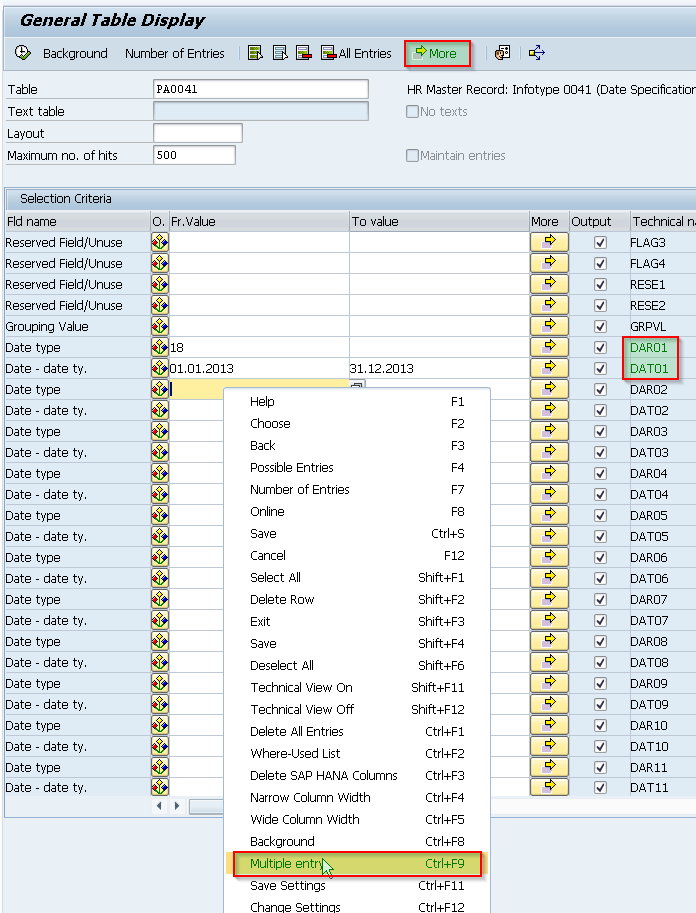
- SAP Community
- Groups
- Interest Groups
- Application Development
- Blog Posts
- Do you know your SE16N?
- Subscribe to RSS Feed
- Mark as New
- Mark as Read
- Bookmark
- Subscribe
- Printer Friendly Page
- Report Inappropriate Content
Probably, this does not exactly belong here, but i found no better place for it.
Several people i know(me included) like to use TA SE16N for a quick glance at table data or as a means of preselection e.g. for personnel data.
Something like a query but without the hassle of building one.
It's really great, as long as you only need data from a single table AND all selection criteria are AND related. (Or so I thought)
One problem, I frequently ran into, is when you want to evaluate a "nested" table. That is a table that has multiple fields in its structure, basically for the same data, representing a limited table in maintenance view.
For example infotype tables in HR are often built like that and the problem is always, that you do not know, in which field (nnnn01, nnnn02, …) to look for a certain value.
Now quite I recently figured out, that SE16N can do that and I found it worth sharing.
Let's assume, you need to know all employee, that have a certain date type (say 18) in infotype 41, in a specific time interval, but you have no idea, in which date type column (DAR01, DAR02,…) it is to be found.
In the past, I would have run several selections, each one with a different DARxx targeted to my date type and then would have assembled the results in Excel.
This is how to do it now
- Call TA Se16N with table PA0041
- Fill in the first set of selection criteria (DAR01 / DAT01)
- Change to Technical View On (SHIFT+F11 or right-click for context menu)

- Select Multiple entry (Cntrl+F9 or right-click for context menu or More button in the top)

Youwill be rewarded with an additional, empty selection screen - Fill in your selection criteria and then press Next Entry (F5 Or Right Arrow in the bottom)

You get a new empty selection screen. Note the number shown in the top line, it will increase as you circle through your value sets.
- Repeat
- When you're through with typing in your values in every possible column, press F8 to get back to your starting selection.
The only hint, that there are additional select criteria, is the more button in the top, now showing the filled Icon.

The difference is in the result. After executing your selection, you will now receive all entries, that match either of your value sets. They are each linked by OR-relation.
Of course, the use of this feature is in no way limited to HR Infotype tables. It's just the most common use for me.
Wherever you need OR-related sets of values for a SE16N Selection , this feature comes in handy.
Hope you'll enjoy it.
- SAP Managed Tags:
- ABAP Development
- « Previous
-
- 1
- 2
- Next »
You must be a registered user to add a comment. If you've already registered, sign in. Otherwise, register and sign in.
-
A Dynamic Memory Allocation Tool
1 -
ABAP
8 -
abap cds
1 -
ABAP CDS Views
14 -
ABAP class
1 -
ABAP Cloud
1 -
ABAP Development
5 -
ABAP in Eclipse
2 -
ABAP Keyword Documentation
2 -
ABAP OOABAP
2 -
ABAP Programming
1 -
abap technical
1 -
ABAP test cockpit
7 -
ABAP test cokpit
1 -
ADT
1 -
Advanced Event Mesh
1 -
AEM
1 -
AI
1 -
API and Integration
1 -
APIs
9 -
APIs ABAP
1 -
App Dev and Integration
1 -
Application Development
2 -
application job
1 -
archivelinks
1 -
Automation
4 -
BTP
1 -
CAP
1 -
CAPM
1 -
Career Development
3 -
CL_GUI_FRONTEND_SERVICES
1 -
CL_SALV_TABLE
1 -
Cloud Extensibility
8 -
Cloud Native
7 -
Cloud Platform Integration
1 -
CloudEvents
2 -
CMIS
1 -
Connection
1 -
container
1 -
Debugging
2 -
Developer extensibility
1 -
Developing at Scale
3 -
DMS
1 -
dynamic logpoints
1 -
Eclipse ADT ABAP Development Tools
1 -
EDA
1 -
Event Mesh
1 -
Expert
1 -
Field Symbols in ABAP
1 -
Fiori
1 -
Fiori App Extension
1 -
Forms & Templates
1 -
General
1 -
Getting Started
1 -
IBM watsonx
1 -
Integration & Connectivity
9 -
Introduction
1 -
JavaScripts used by Adobe Forms
1 -
joule
1 -
NodeJS
1 -
ODATA
3 -
OOABAP
3 -
Outbound queue
1 -
Product Updates
1 -
Programming Models
14 -
Restful webservices Using POST MAN
1 -
RFC
1 -
RFFOEDI1
1 -
SAP BAS
1 -
SAP BTP
1 -
SAP Build
1 -
SAP Build apps
1 -
SAP Build CodeJam
1 -
SAP CodeTalk
1 -
SAP Odata
2 -
SAP SEGW
1 -
SAP UI5
1 -
SAP UI5 Custom Library
1 -
SAPEnhancements
1 -
SapMachine
1 -
security
3 -
text editor
1 -
Tools
18 -
user experience
5
| User | Count |
|---|---|
| 5 | |
| 3 | |
| 3 | |
| 2 | |
| 2 | |
| 1 | |
| 1 | |
| 1 | |
| 1 | |
| 1 |